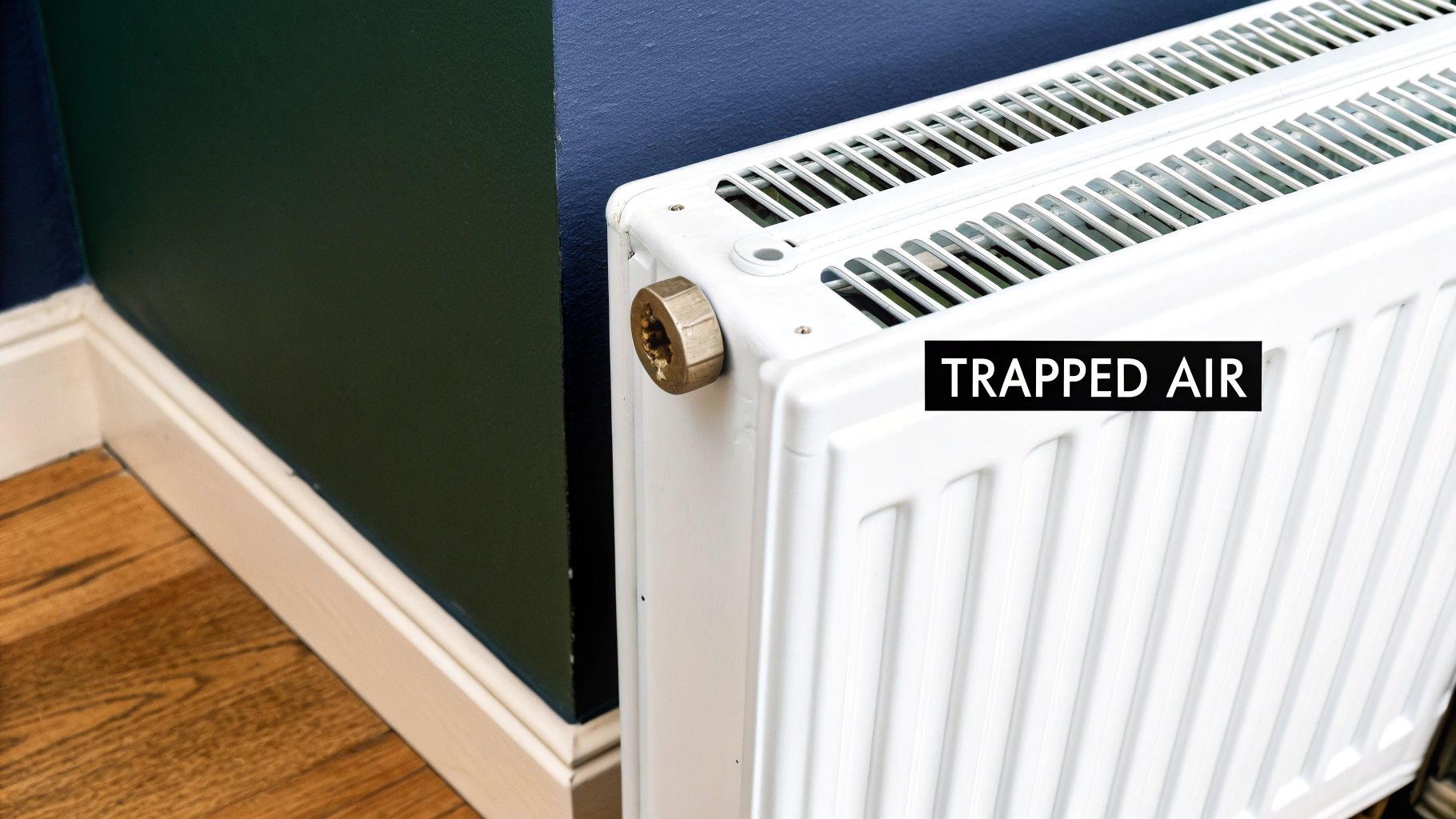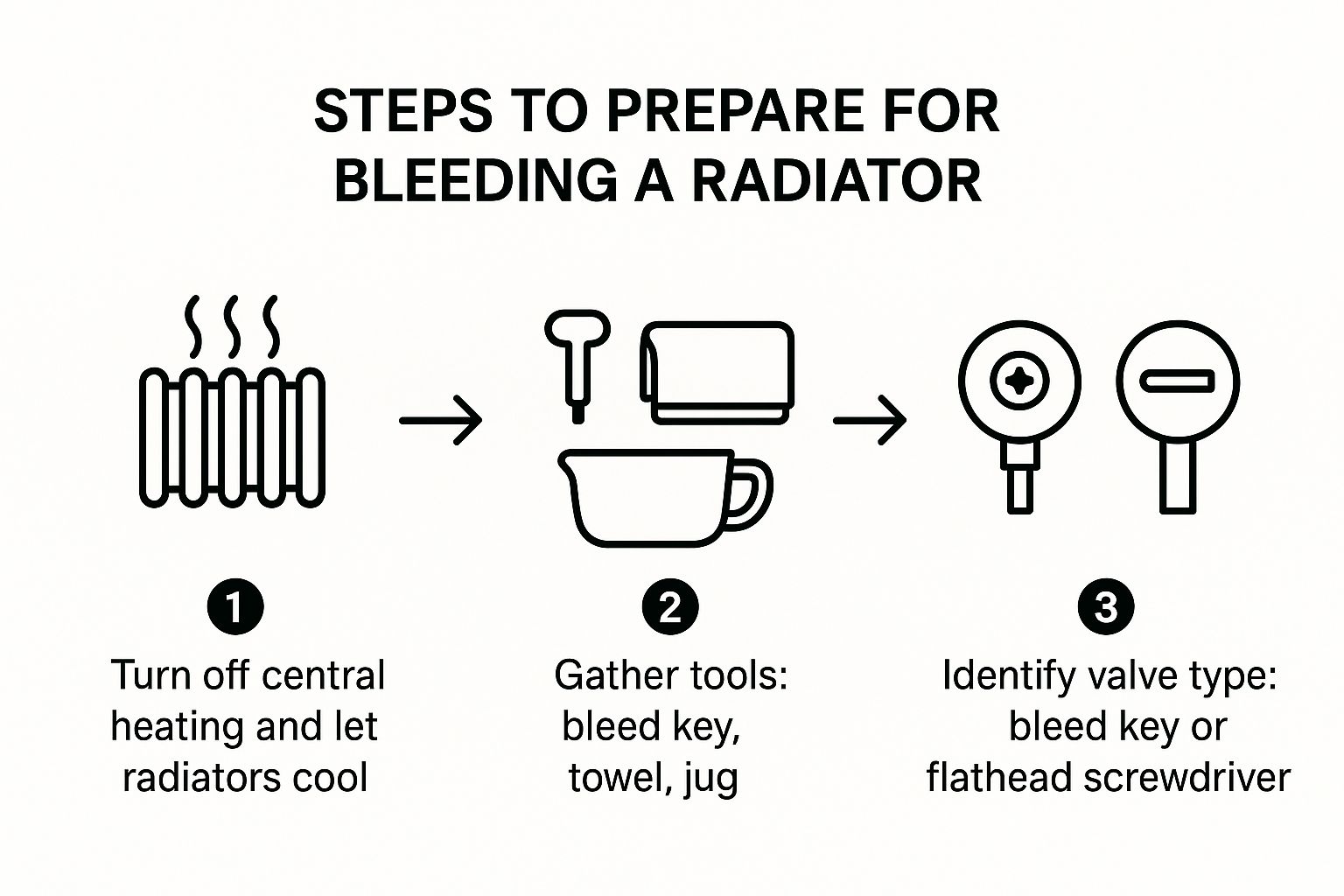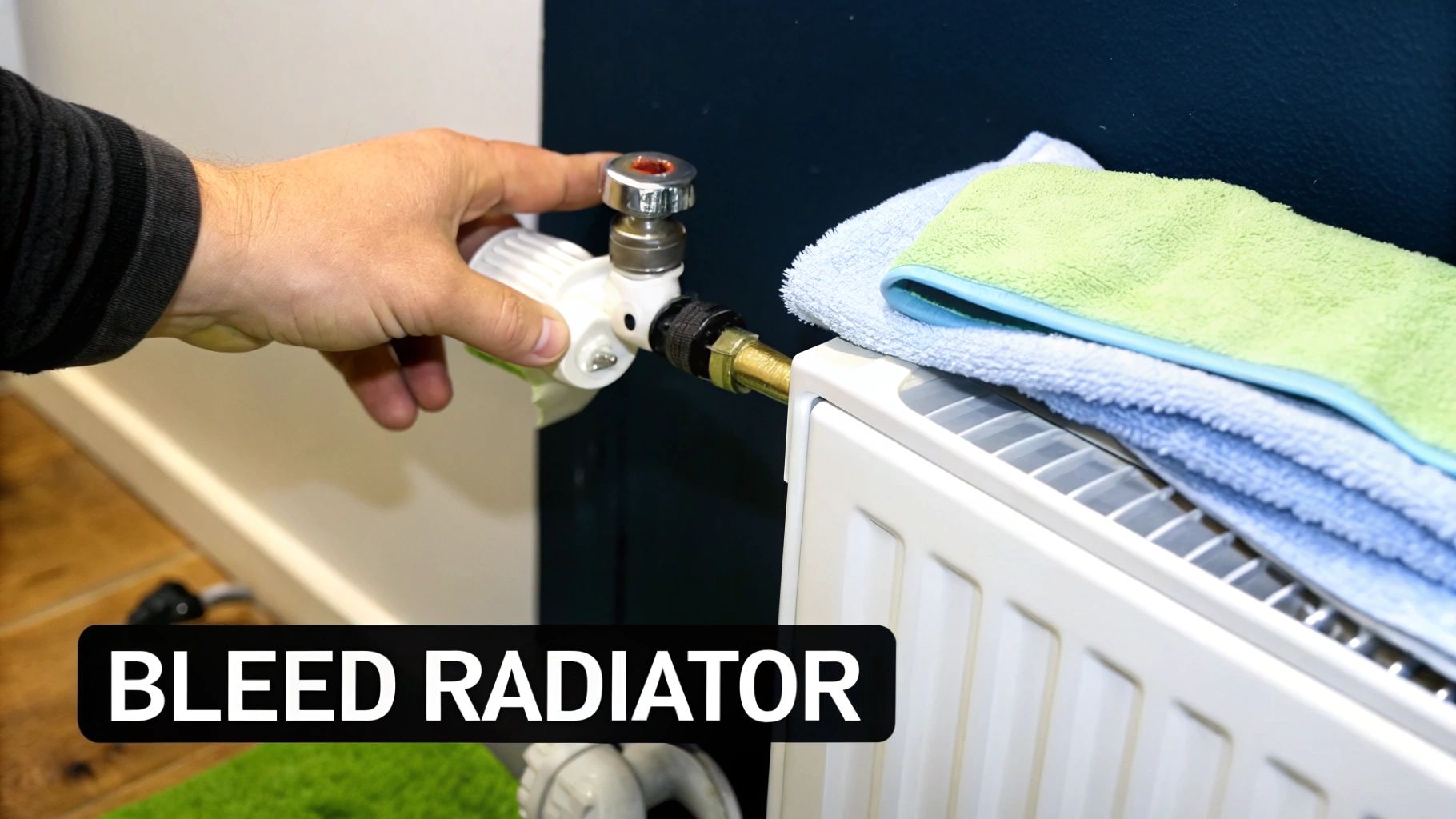Bleeding Radiators Where to Start A UK Homeowner Guide
- Luke Yeates
- Oct 12
- 9 min read
Not sure where to start with bleeding your radiators? It's simpler than you might think. Just find the ones that are cold at the top but still warm at the bottom. This, along with any strange gurgling sounds coming from your pipes, is the tell-tale sign that you've got trapped air messing with your heating.
Why Your Radiators Feel Cold and How to Diagnose the Problem

That gurgling noise you've been hearing isn't just a minor annoyance; it's your heating system's way of telling you something's wrong. When air gets trapped inside, it naturally rises to the top of the radiator. This pocket of air acts like a blockage, stopping the hot water from circulating properly and leaving you with frustrating cold spots.
As a result, your boiler has to work much harder to try and heat the room, which often leads to higher energy bills. Think of it as a quick health check for your heating. For homeowners here in Eastbourne, giving your radiators a quick once-over before the cold weather really bites is a smart move. At Harrlie Plumbing and Heating, we always tell our neighbours that this is one DIY job you can definitely handle yourself.
Quick Signs Your Radiators Need Bleeding
Before you grab any tools, let's confirm if trapped air is really the problem. The table below is a handy checklist for the most common symptoms.
Symptom | What It Means | Action Required |
|---|---|---|
Cold tops, warm bottoms | Air has risen and is trapped at the top of the radiator, blocking hot water. | This is the classic sign. Time to bleed the affected radiators. |
Gurgling or bubbling noises | Water is struggling to flow past the air pockets within the pipes and radiators. | Bleeding the system will remove the air and quieten things down. |
Radiators are slow to heat up | Poor circulation due to trapped air means it takes much longer to warm the room. | Bleeding will restore efficient water flow and speed up heating times. |
The whole radiator is cold | Could be a sign of a bigger issue like a stuck valve or sludge build-up. | Bleed it first. If it's still cold, you may need a professional. |
Running through these checks will give you a clear idea of what's going on. In most cases, a simple bleed is all that's needed to get things running smoothly again.
Regularly bleeding radiators is a key part of keeping your heating system efficient, especially in the UK where we rely on it so heavily. Plumbing experts always recommend doing this just before the main heating season kicks off. It's a simple bit of prep that stops uneven heating before it starts. If you're also wondering whether your radiators are the right size for your rooms, have a look at our guide on UK radiator sizing for a perfectly heated home.
A well-maintained radiator not only keeps your home comfortable but also ensures your heating system runs efficiently, saving you money in the long run. It's a small task with a significant impact.
Getting Your Kit Together for a Clean and Safe Job
Before you even think about touching that radiator valve, a little prep work can be the difference between a quick, simple fix and a messy, frustrating afternoon. You don't need a professional's toolbox for this; just a few basic items will see you right and keep the job clean and safe.
Your essential toolkit is pretty straightforward. You'll need:
A radiator bleed key
A couple of old towels or cloths to protect your flooring
A small jug or bowl to catch any water that drips out (a 200ml container is usually more than enough)
What Kind of Valve Do You Have?
It's worth remembering that not all radiators are built the same. While many older models need a standard bleed key, we often find that newer radiators in Eastbourne homes can be opened with a simple flathead screwdriver. Have a quick look at the bleed valve—it’s that little metal square or screw at the top corner of your radiator—to see which tool you'll need.
This quick infographic breaks down the simple prep you should do before getting started.

As the graphic shows, the absolute first priority is safety, followed by gathering your simple tools.
The most important step, and one our team at Harrlie Plumbing and Heating never, ever skips on a job in Eastbourne, is to turn off your central heating. You absolutely must wait for the radiators to cool down completely before you start.
This isn't just a friendly suggestion; it's a non-negotiable safety rule. Trying to bleed a hot radiator can cause scalding water to spray out under pressure, which can lead to some really serious burns. Always let the system cool right down for a smooth, safe process.
A Practical Walkthrough of Bleeding Your Radiators

Alright, let's get hands-on. With your heating switched off and your tools at the ready, you can get started. One of the first questions we get from homeowners in Eastbourne is "which radiator do I start with?". The most effective way is to begin with the radiator furthest from your boiler.
If you're in a house with more than one floor, start downstairs and work your way up. For example, if your boiler is in the kitchen at the back of your Eastbourne terrace house, you'd start with the living room radiator at the front, then move upstairs to the furthest bedroom. This systematic approach is the best way to push all the trapped air out of the system properly, preventing it from just moving into another radiator along the way.
Releasing the Trapped Air
First, find the bleed valve. It’s that small square or screw-in-a-nut you'll see at the top corner of the radiator. Pop your old towel on the floor right underneath it to catch any drips and hold your jug or bowl just below the valve itself.
Now, fit your radiator key or flathead screwdriver onto the valve. Gently turn it anti-clockwise—often, just a quarter turn is enough. You really don’t need to force it. You should immediately hear a hissing sound. That's a good thing! It’s the sound of trapped air escaping.
Our Pro Tip: Don't be tempted to open the valve all the way. A slow, steady release is far more controlled and stops water from spraying out everywhere once the air is gone. It's a simple detail our Harrlie Plumbing and Heating engineers always follow for a clean, mess-free job in homes across Eastbourne.
Once the hissing stops and you see a steady trickle of water, you know you’ve got all the air out. Immediately turn the key clockwise to close the valve firmly, but be careful not to overtighten it. Give any drips a quick wipe with your cloth, and that's one radiator done.
Timing Your Maintenance Perfectly
Knowing when to check your radiators can make a real difference to how comfortable your home is when the cold weather hits. In the UK, the best time to think about this is just before winter truly sets in. In fact, expert advice suggests the window between October 13th and 17th is ideal for switching on your heating for the first time, as this is when average temperatures tend to consistently drop below 15°C. You can learn more about preparing your heating for winter on idealhome.co.uk.
Checking Your Boiler Pressure After Bleeding
Once the last radiator has stopped hissing and you’ve tightened up the bleed valves, you’re nearly there. But don’t be tempted to put your tools away just yet—there’s one final, crucial job to do.
When you bleed your radiators, you’re not just releasing trapped air; you're also letting out a bit of pressure from the entire central heating system. If you leave the pressure too low, your boiler simply won't work as it should, and you’ll find yourself right back where you started with a cold house.
That’s why you absolutely must check the boiler’s pressure gauge. Head over to your boiler and have a look for a small dial, which is usually marked with some handy coloured sections.
Understanding the Pressure Gauge
That little needle on the pressure gauge is your window into the health of the system. It tells you exactly how much water pressure is currently in your heating circuit.
For the most accurate reading, you should check this when the heating is off and the system is cool. You’re looking for a pressure between 1 and 1.5 bar. Most gauges have a green zone to show you this is the sweet spot for safe operation.
If the needle has dipped below 1 bar, perhaps even into a red zone, don't panic. It's a completely normal thing to happen after you've been bleeding radiators. It just means you need to top up the system to get it back into that green zone.
A Note on Topping Up: Repressurising, or 'topping up', a boiler is usually done with a filling loop. This is a small, often silver, flexible hose with a valve at each end, typically found underneath your boiler. Opening the valves lets a small amount of mains water into the heating system, which brings the pressure back up. Keep a close eye on the gauge and shut the valves as soon as the needle hits 1.5 bar.
Many homeowners in Eastbourne, especially those with older systems they aren't familiar with, can feel a bit hesitant about this part. If you’re not confident, the smartest and safest move is to call in a professional. At Harrlie Plumbing and Heating, we can get this sorted for you in minutes and double-check that everything is working perfectly.
Regular checks are key to a healthy boiler, which is why we've put together our guide on how to service a boiler for Eastbourne homeowners.
Troubleshooting Lingering Radiator Issues
Sometimes, you can do everything right—bleed every radiator in the house—and still find your heating isn’t quite up to scratch. It’s a frustrating feeling. If you’ve released all the trapped air but a radiator remains hot at the top and stubbornly cold at the bottom, the problem isn’t air anymore.
This is a classic symptom of sludge buildup. Over the years, rust, limescale, and other debris can settle at the bottom of a radiator, forming a thick, dense sludge. This gunk effectively blocks hot water from circulating properly, and no amount of bleeding is going to shift it.
When To Consider A Powerflush
When sludge is the culprit, the most effective solution is often a system powerflush. This process involves a professional using specialist equipment to pump cleaning chemicals through your heating system at high velocity, breaking down and flushing out all that accumulated sludge.
A powerflush is not a DIY job. It requires specific expertise and equipment to be done safely and effectively. For homeowners in Eastbourne dealing with persistent cold spots, it's the best way to restore your heating system's efficiency.
If you suspect this might be what’s plaguing your system, you can learn more about what’s involved in our guide on what is power flushing your heating system.
Other lingering issues might include a stuck or leaking bleed valve. Occasionally, the problem can stem from the radiator valves themselves; this helpful resource on how to install radiator valves can provide more insight if you suspect a valve problem.
Knowing when to call in a professional is key. While bleeding a radiator is a straightforward DIY task, tackling sludge or faulty valves is best left to the experts. The average cost to have a professional bleed a single radiator is around £100, though emergency call-outs can be more. For complex jobs, our Harrlie Plumbing and Heating team is always ready to help our Eastbourne clients.
Your Radiator Bleeding Questions Answered
To wrap things up, let's go over a few common questions we often hear from homeowners around Eastbourne. Getting these answers sorted can give you that extra bit of confidence before you start bleeding your radiators.
How Often Should I Bleed My Radiators?
A good rule of thumb is to check your radiators once a year, usually just before autumn makes way for winter. That said, if you start hearing any of those tell-tale gurgling sounds or notice cold spots at the top, that's your cue to get the bleed key out, no matter the season. We often remind our Eastbourne customers to do this when the clocks go back.
Should I Bleed All Radiators or Just the Cold One?
It’s tempting to just fix the one that’s clearly playing up, but it's always best practice to check every radiator in your home. Air can easily move through the entire system.
By working your way from the radiator furthest from the boiler, you can be sure you’ve cleared out every last air pocket for a fully efficient system.
Why Is My Radiator Still Cold at the Bottom?
This is a classic sign of sludge and grime build-up, not trapped air. This kind of blockage stops hot water from circulating properly through the bottom of the radiator. Unfortunately, bleeding won't fix this one; your system will most likely need a professional powerflush to clear everything out. Harrlie Plumbing and Heating regularly performs powerflushes in Eastbourne to solve exactly this problem.
Beyond immediate heating worries, a key part of being a homeowner is protecting your property. For instance, it's vital to get a clear picture of your UK Rebuild Cost for Insurance Explained to make sure you're fully covered if the worst should happen.
If you've given bleeding a go and are still stuck with cold spots or low boiler pressure, don't hesitate to call in the professionals. For expert advice and reliable service in Eastbourne, get in touch with Harrlie Plumbing and Heating today at https://www.harrlieplumbing.co.uk.

Comments